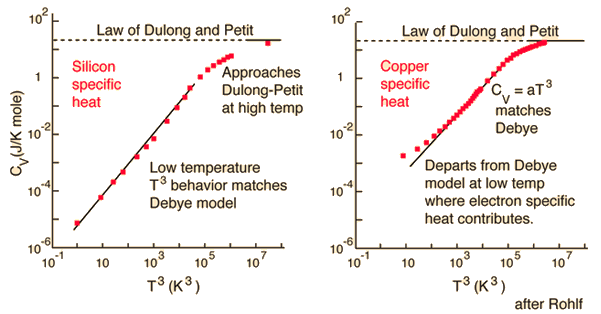Debye's Contribution to Specific Heat Theory
Einstein's oscillator treatment of specific heat gave qualitative agreement with experiment and gave the correct high temperature limit (the Law of Dulong and Petit). The quantitative fit to experiment was improved by Debye's recognition that there was a maximum number of modes of vibration in a solid. He pictured the vibrations as standing wave modes in the crystal, similar to the electromagnetic modes in a cavity which successfully explained blackbody radiation. The density of states for these modes, which are called "phonons", is of the same form as the photon density of states in a cavity.
To impose a finite limit on the number of modes in the solid, Debye used a maximum allowed phonon frequency now called the Debye frequency υD. In the treatment of specific heat, we define a Debye temperature by

For low temperatures, Debye's treatment led to a specific heat
 |
|
The dependence upon the cube of the temperature agreed with experimental results for nonmetals, and for metals when the electron specific heat was taken into account. The measurement of the low temperature specific heat variation with temperature has led to tabulation of the Debye temperatures for a number of solid materials. The full expression for the Debye specific heat must be evaluated by numerical procedures. It has the correct limiting values at both high and low temperatures.
| Define constants | Table of specific heats |
| Einstein-Debye specific heat expression |
Reference
Rohlf
Ch 14.
Blatt
Sec. 4.3
| HyperPhysics***** Thermodynamics | R Nave |

